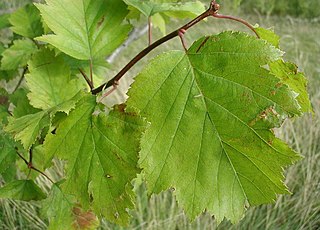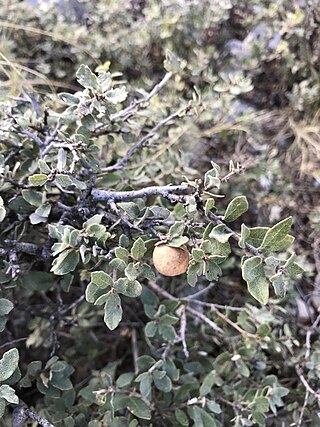
Satureja is a genus of aromatic plants of the family Lamiaceae, related to rosemary and thyme. It is native to North Africa, southern and southeastern Europe, the Middle East, and Central Asia. A few New World species were formerly included in Satureja, but they have all been moved to other genera. Several species are cultivated as culinary herbs called savory, and they have become established in the wild in a few places.

Grevillea intricata is a species of flowering plant in the family Proteaceae and is endemic to the west of Western Australia. It is a densely-branched shrub with tangled branchlets, divided leaves with linear lobes and clusters of pale greenish-white to light cream-coloured flowers.

Freyer's pug is a moth of the family Geometridae. The species can be found in Europe, east to the Urals, the Russian Far East, Kazakhstan and China. It is also found in North America.

Crataegus intricata is a species of hawthorn known by the common names Copenhagen hawthorn, Lange's thorn and thicket hawthorn. It is native to eastern Canada and the eastern United States. Its fruit are brown to red.
Drosera intricata is a scrambling or climbing perennial tuberous species in the carnivorous plant genus Drosera that is endemic to Western Australia. It grows in clay-sand soils on swamp margins, or other habitats that are seasonally wet. D. intricata produces small carnivorous leaves along a glabrous stem that can be 25–40 cm (10–16 in) tall. Its 3-12 yellow flowers emerge from September to October. It gains its species name, intricata, from its twining or winding habit.
Bailya intricata is a species of sea snail, a marine gastropod mollusc in the family Pisaniidae.
Payraudeautia intricata is a species of predatory sea snail, a marine gastropod mollusk in the family Naticidae, the moon snails.
Payraudeautia is a genus of predatory sea snails, marine gastropod mollusks in the family Naticidae, the moon snails.

Quercus intricata, common name dwarf oak, intricate oak or Coahuila scrub oak, is a plant species native to northern Mexico and western Texas.

Hermeuptychia intricata, the intricate satyr is a butterfly of the family Nymphalidae. It has been recorded from the coastal plains of the eastern United States and is currently documented from Texas, Louisiana, Florida, South Carolina, and North Carolina.

Sophronica is a genus of longhorn beetles of the subfamily Lamiinae, containing the following species:
Sophronica bimaculipennis is a species of beetle in the family Cerambycidae. It was described by Stephan von Breuning in 1955, originally under the genus Sophronisca. It is known from Ghana, the Ivory Coast, and Guinea. It contains the varietas Sophronica bimaculipennis var. besnardi.
Sophronica postscutellaris is a species of beetle of the genus Sophronica, in the family Cerambycidae. It was described by Stephan von Breuning in 1954.
Sophronica rufiniceps is a species of beetle in the family Cerambycidae. It was described by Stephan von Breuning in 1949. It is known from the Central African Republic, Angola, the Ivory Coast, the Democratic Republic of the Congo, Cameroon, and Uganda.
Sophronica rufobasiantennalis is a species of beetle in the family Cerambycidae. It was described by Stephan von Breuning in 1948. It contains the varietas Sophronica rufobasiantennalis var. ovalis.
Sophronica rufulescens is a species of beetle in the family Cerambycidae. It was described by Stephan von Breuning in 1940. It feeds on the Monterey pine.
Sophronica subdivisa is a species of beetle in the family Cerambycidae. It was first described by Stephan von Breuning in 1940.
Sophronica angusticollis is a species of beetle in the family Cerambycidae. It was described by Per Olof Christopher Aurivillius in 1928. It is known from Somalia, Ethiopia, Tanzania, and Kenya.
Sophronica grisea is a species of beetle in the family Cerambycidae. It was described by Per Olof Christopher Aurivillius in 1908.
Sophronica amplipennis is a species of beetle in the family Cerambycidae. It was described by Francis Polkinghorne Pascoe in 1888.






